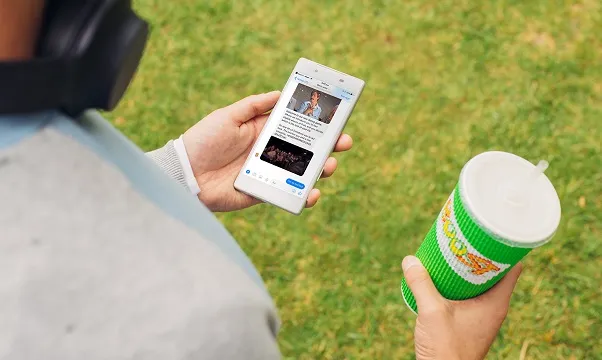
Chatbots are being used by Boost Juice and other QSRs to disrupt the rules of customer engagement
From its inception, the conversation on the use of chatbots in 2018 continues to be a polarising subject.
For some, chatbots – programs powered by artificial intelligence (AI) and algorithmic rules designed to simulate a digital chat service – are the future in brand opportunities due to a rising use of social platforms. Others surmise that it’s a distraction that diminishes the inherent need for the human element.
Until now, the initial and continuous uptick in optimism for chatbots that are uttered in the name of efficiency is still usually coupled with skepticism and apprehensions that revolve around its impact in human interaction.
What is undeniable, either way, is that the chatbot technology has disrupted the rules of engagement in customer service.
“Many thought they were talking to a real person”
Boost Juice in Australia, known for catering to both children with colorful smoothies and adult fitness buffs who want to load up on their energy levels, continued to push the boundaries of customer engagement and made headlines last year after launching their Matcha Chatbot.
The Facebook Messenger software aimed to “match” users to their perfect fruit or vegetable, where they need to "woo" the personas (also chatbots) to score themselves a Boost voucher and ultimately a trip to Japan where they "marry their perfectly matched fruit."
Boost Juice’s chief technical innovation officer Christian McGilloway tells QSR Media that the brand was “pretty amazed” at the engagement levels they learned from doing the Matcha campaign. According to provided data, a total of 117,000 unique users engaged in a total of 370,000 chatbot conversations.
“Over 68% of players reached Day 12 of the game with their Matcha Bot favourite ‘Coconut’, and we experienced a 20% redemption rate which is a fantastic result for the business. We saw huge levels of player engagement and affinity with the Matcha fruit bots, [with] many players actually thought they were talking to a real person. We still get the odd late night request from players to talk to their Perfect Matcha fruit character,” McGilloway said.
The campaign also met initial criticism for its use of language but Boost says that it was well-received by both customers and other brands, giving them valuable learnings on customer engagement and digital strategies.
“Matcha Bot generated a lot of noise on social media from our customers, so it would have been great if we were able to leverage this. We didn’t integrate the Boost Juice app to the Matcha Bot, which would have allowed us more customer insights and retention rates to convert to our loyalty programme. We’ve taken this learning and applied it to our most recent digital offering, our second gamification app ‘Find the Fruit’.”
Reflecting on their success, McGilloway says they are looking into further exploration into chatbot technology to potentially improve their customer service processes, including brand interaction and their feedback mechanism.
“We’re looking at simplifying the process for our customers, and chatbot technology could be an effective means of moving towards providing customer service 24/7. Of course, more serious customer enquiries will always be handled by our customer service team, and we want to make sure we always have the appropriate resources to ensure an effective overall customer response,” he added.
Chatbots: the face of AI?
Gartner predicts that by 2021, more than half of 50% of enterprises will spend more on bots and chatbot creation per year compared to mobile applications. Claiming that a “post-app era” will come, the research firm says that chatbots will become the “face of AI” and will affect the way apps are currently being developed.
This prediction is reinforced by a Business Insider report in 2016 where 80% of their respondents from France, the Netherlands, South Africa, and the United Kingdom said they already utilised or planned to use chatbots by 2020. 42% believe automation technologies such as chatbots will guarantee improvement in the customer experience in terms of sales, marketing, and customer service.
Meanwhile, a late 2017 survey by Chatbots.org reveals that 53% of 3,000 respondents in the U.S. and U.K. who have used a chatbot for customer service found them to be “not effective” or “somewhat effective”.
Between the two countries, 14% of consumers in the U.S. assessed that chatbots were “not effective” in contrast to U.K. consumers’ 5%. “This is perhaps an indication that US consumers are challenging chatbots with more complex questions than UK consumers,” the independent survey stated.
In terms of consumer age, the survey suggests that younger consumers – the more digitally-savvy Generation Z and millennials – perceive chatbots with a more “positive attitude” compared to baby boomers and the silent generation. Data shows that 22% of Generation Z and 15% of millennials rated chatbots as “very effective”, while both consumers who are boomers and part of the silent generation gave it the same rating at 12%.
13% of respondents with undergraduate or graduate degrees on the other hand gave a “not effective” rating to chatbots compared to 7% of consumer with high school diplomas or incomplete high school education. The report explains that this could be due to “educated consumers challeng[ing] chatbots to resolve more complex service problems.”
Using chatbots beyond cost reduction
Businesses typically foray into the chatbot space wanting to cut costs. Forrester analysts, however, think that their strategies need to go beyond cost reduction.
In their report, they detected a couple of missteps in chatbot strategies: focus on contact deflection and in replacing instead of augmenting human agents.
Instead of focusing on reducing costs, Forrester recommends to optimize costs instead while gaining insight from the “unrestrained voice” of the customer and enhancing the experience between the customer and the human agent behind the chatbot.
“Determining what success means for chatbots differs from company to company. Whether the benefits of deploying a chatbot are aligned with cost, experience, or even revenue gains, you need to define the metrics for success within your organisation. From there, you need to create a framework for chatbots to become increasingly intelligent and evolve with your customers’ ever-changing needs,” the report explains.
The person behind personalised customer service
But despite the stream in going digital, some QSRs emphasize that a person is still the value-adding factor behind a personalized customer service.
“Whilst digital can certainly amplify the personification of a guest’s experience, we believe that it does not replace the human interaction our team members have with our guests. It may sound simple, by ensuring our guests are served using their name is a basic yet important step in providing an exceptional guest experience,” The Coffee Emporium head of marketing Tania Minchella said in an interview.
The Coffee Emporium, which was built from a rustic coffee shop in 2002, has evolved to a European-style coffee shop with over 40 coffee houses in and out of Australia. Like most QSRs, they too are continually leveraging technology to enhance the guest experience.
“We are currently undertaking a number of projects that will allow us to use the power of digital to deliver not only more personalised communications, but also consistently deliver the most exceptional coffee house customer service.”
While they are open to exploring new and emerging technologies such as the chatbot, Minchella emphasizes that what sets them apart is their philosophy of still being in “the people business.”
“Humanised Interaction and personalised experience still remains fundamental to the way we interact with guests on every level. This for us is especially important when it comes to replying to guest feedback and reviews. The digital landscape gives customers even more ways to share and express their feedback. We are committed to replying to each and every one, whether it is negative or positive, personally. Our guests are the very reason we are in business, and they deserve to be serviced with personalised treatment and regard,” she added.
Notwithstanding how 'human' and experiential the coffee experience is, The Coffee Emporium sees the middle ground between technology and establishing genuine rapport with their customer base.
“We see digital technology as a vehicle to enhance this relationship building process by providing our business with more information about the individual needs of our guests. This allows us to deliver relevant products, communications and offers that deliver on our guests wants, needs and expectations.”























